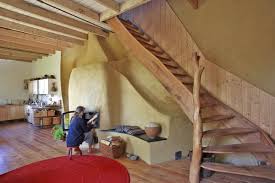Mass heater I find a suitable name for massive, stony heaters that warm up slowly by one (up to 2) short heating periods of about two hours a day to give then approximately 12 hours (IR) radiation heat. As a result, not (much) the indoor air is heated, but floors, walls, objects and people in the near radiation zone. The thermometer measures little, and behind a wall or object you feel no effect. (In contrast to the most commonly used convection heat, which heats the air for heat transfer.)
 The finish of the 700 kg to 5 ton construction (which must have solid foundations) makes it a tiles stove (or ceramic stove), a finnoven (Finnish soapstone) or a clay stove. Finishing plaster is another possibility. Also, refractory brick, concrete, clay brick (or grog) and masonry may be used or combined. By using mingled materials different coefficients of expansion can cause cracks. In clay is often used chicken wire as reinforcement.
The finish of the 700 kg to 5 ton construction (which must have solid foundations) makes it a tiles stove (or ceramic stove), a finnoven (Finnish soapstone) or a clay stove. Finishing plaster is another possibility. Also, refractory brick, concrete, clay brick (or grog) and masonry may be used or combined. By using mingled materials different coefficients of expansion can cause cracks. In clay is often used chicken wire as reinforcement.
Tiles stoves exist since 1300, and were a significant improvement over the fireplace. They are economical, environmentally friendly, and there are no fumes in the house.
The energy efficiency is 80 to 90 percent.
For metal stoves or central heating is that 40 to 50 percent, and only 10 to 15 percent for a fireplace (where most of the heat disappears through the chimney).
The boiler room seems ridiculously small compared to the stove.
The temperature in the combustion chamber can be up to around 1000°C. As a result, the combustion of wood is more complete and less polluting than at the lower temperature in iron stoves. Metal heats up quickly, but it also cools down quickly. A mass heater is therefore always intensively fired, even if a lower temperature is desired.
Burn 1 kg of wood per 100 kg mass heater. More does not make sense, the saturated mass can not absorb any additional heat.
The yield is high due to the use of counter flow channels. The hot flue gases are led from the top first back down. They go through a sometimes complex maze of gas channels and indoors chambers. They hold the hot smoke as long as possible before being discharged outside (at about 200 ° C) to give as much heat to the stone. The mass of the stove accumulates the heat difference. The heat is given later by the outer wall. Light stoves lose this advantage and yield models.
The surface is unlike metal pleasantly warm, and suitable as a seat or couch. The material allows each design: kick heaters, stoves tree, climbing stoves...
A mass heater may also have an oven or stove.
The required combustion air is best achieved through a tube directly from the outside instead of the room (and possibly pre-heated by pipes through the mass).
You can overnight stoke the stove depending on the size, the outside temperature and the desired temperature so than she in the closed space can release her heat for accumulation in floors and wall to get a comfortable temperature.
To enjoy a mass heater you invest as much in insulation as in the purchase of the stove. (Use infrared reflective material.) Never make a tiled stove at a (not isolated) outside wall.
Disadvantages of a mass stove
The slow operation. There is no fine tuning. You cannot easily just heat a little. It takes a few hours. And stays for hours. Planning and experience are required.
Difficult for nowadays working couples. The stove would be better placed in a low- energy concept with a modified lifestyle.
She heats only one room, unless you use additional systems. Combinations of boilers and central heating are possible.
They are expensive. Mainly by labor: the material itself is not that expensive. Building yourself requires some expertise. (See also <Loam oven>). There are workshops. And on the Internet you can find plans and videos.
